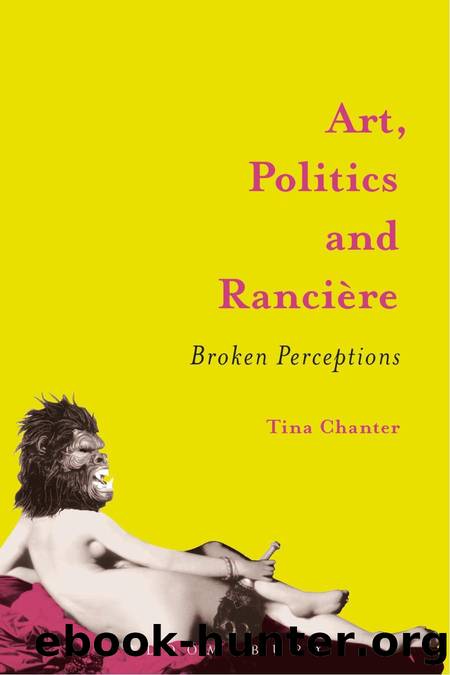Art, Politics and Rancire by Tina Chanter;

Author:Tina Chanter; [Chanter;, Tina]
Language: eng
Format: epub
ISBN: 9781472510945
Publisher: Bloomsbury
Published: 2019-11-23T00:00:00+00:00
5
Framing and Reframing Rancièreâs Critical Intervention: Foucault and Kant
In this chapter I follow, sometimes closely and sometimes more loosely, the conceptual development of an essay in which Rancière tackles head-on what I take to be the central defining issue of his work, namely, how to construe the relation between art and politics. At the same time, I situate Rancièreâs argument in the essay âThe Paradoxes of Political Artâ in the context of some of his most decisive philosophical precursors, drawing strategically on some key texts and ideas in his broader corpus, and developing some suggestions embedded in his critical interventions to indicate two of the decisive framing mechanisms on which he draws in explicating his argument. I adopt this approach as it seems particularly suited to shed light on Rancièreâs thinking, the articulation of which is often strewn with shorthand phrases which summarily condense complex moves he elaborates more fluidly, with more precision and exactitude, elsewhere in his corpus. I expand the suggestion broached in the previous chapter that Rancièreâs understanding of the aesthetic regime is indebted both to Kant and to Hegel (though I focus more upon Kant in this chapter) by showing that it is in inheriting and reinvigorating a Foucauldian problematic that Rancière effects a displacement of Kantâs transcendental approach, while at the same time breathing new life into Hegelâs dialectical reconciliation of opposites. I will specify two respects in which Rancièreâs argument is indebted to Foucault. If Rancièreâs modification of Foucault can be identified as a more immediate framing mechanism, he also embeds this framework within a wider retrospective historical sweep, which, as we have seen, looks back to Plato and Aristotle, in terms of whom he specifies the ethical and representative regimes, elements of which still inhabit contemporary politics of art. This is not of course to suggest that there are no other decisive philosophical influences on Rancière, only to elaborate the way in which I think these key figures play into Rancièreâs philosophical framing and formulations.
Let me begin by describing the specific polemic in terms of which Rancièreâs argument advances, before going on to frame it in the broader contexts indicated above. At one level, the narrative arc of âParadoxesâ moves from one model of the efficacy of art to another, from a pedagogical model to a dissensual or paradoxical model. The polemical insight that informs this shift, which will be the focus of this chapter, is wielded against contemporary art that takes itself to be politically subversive, yet remains entrenched in pedagogical logics that fail to move beyond the mimetic assumptions of the ethical and representative regimes that Rancière articulates, and which constitute the conceptual architecture against which his arguments unfold. As we have seen, Rancière suggests that pedagogical logic posits an unproblematic, direct causal relationship between the intention animating the artist and the spectator viewing art. The artwork is the vehicle that transmits or conveys to the audience a transformative effect; the artistâs intention is to mobilize the spectatorâs intervention into the
Download
This site does not store any files on its server. We only index and link to content provided by other sites. Please contact the content providers to delete copyright contents if any and email us, we'll remove relevant links or contents immediately.
| Anarchism | Communism & Socialism |
| Conservatism & Liberalism | Democracy |
| Fascism | Libertarianism |
| Nationalism | Radicalism |
| Utopian |
The Secret History by Donna Tartt(18763)
The Social Justice Warrior Handbook by Lisa De Pasquale(12086)
Thirteen Reasons Why by Jay Asher(8743)
This Is How You Lose Her by Junot Diaz(6707)
Weapons of Math Destruction by Cathy O'Neil(6089)
Zero to One by Peter Thiel(5642)
Beartown by Fredrik Backman(5552)
The Myth of the Strong Leader by Archie Brown(5379)
The Fire Next Time by James Baldwin(5204)
How Democracies Die by Steven Levitsky & Daniel Ziblatt(5100)
Promise Me, Dad by Joe Biden(5040)
Stone's Rules by Roger Stone(4993)
100 Deadly Skills by Clint Emerson(4802)
A Higher Loyalty: Truth, Lies, and Leadership by James Comey(4802)
Rise and Kill First by Ronen Bergman(4662)
Secrecy World by Jake Bernstein(4598)
The David Icke Guide to the Global Conspiracy (and how to end it) by David Icke(4562)
The Farm by Tom Rob Smith(4408)
The Doomsday Machine by Daniel Ellsberg(4379)
